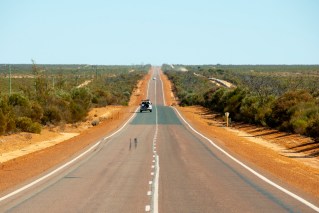Sydney’s tram wrong turn and other reasons the transport system broke

Sydney got rid of its trams, Melbourne's still have a chance. Photo: City of Sydney
Residents of Sydney experience many transport problems on a daily basis, ranging from congested roads to overcrowded and delayed trains. These problems are persistent and seem to become worse.
Sydneysiders are often envious of European cities with good subway systems.
Residents wonder why travelling is so problematic in our city and whether bad transport planning is at fault.
Crowding is part of city life
The first thing to realise is that congestion and crowding problems are part of city life all around the world and will not disappear.
These problems occur since travel demand exceeds the supply of infrastructure and transport services during peak hours.
It is possible to entirely solve congestion and crowding issues by building much more infrastructure and offering many more train and bus services, but this is unlikely to happen because it is not good use of money.”
Compare it to queues during peak hours in a supermarket; these queues could be entirely avoided by adding more checkouts, but this also means that many checkouts sit idle for a large part of the day and hence adding more checkouts is not deemed a good investment.
In other words, congestion on roads and crowds in trains are indicators that existing infrastructure is utilised efficiently.
Further, there is simply not enough space in cities to keep building more infrastructure, unless they go underground at a significant cost.
It is all about density
Transport planning and investment in infrastructure cannot be seen independent from urban planning.
The urban blueprints of European cities have been established in a time where cars were not yet available, making them relatively compact and high density. Compact and high-density cities are ideal for train and metro systems since many people can be served by a single station.
In contrast, Sydney is a relatively new city and like many US cities it has a much lower density (outside the CBD) and large urban sprawl due to the urban planning – stemming from a time when car-dominant city design was not yet perceived as a problem.

Urban sprawl. Photo: AAP
Low densities makes it economically infeasible to develop a dense rail network of train or metro lines throughout the city. Sydney is therefore, at least outside the CBD, very dependent on road transport by car (and bus).
Unfortunately, cars are among the most inefficient modes of transport with respect to required space. As estimated by the United Nations Economic and Social Commission for Asia and the Pacific, for each lane of 3.5 metres wide only about 2000 people per hour are transported, compared with around 22,000 per hour for a tram and 80,000 or more per hour for a train.
According to Charting Transport, the population density in London (80 people per hectare) and Paris (133 people per hectare) is significantly higher than Sydney (36 people per hectare), making transport planning in Sydney very challenging.
Without sufficient density, it is not feasible to build an economically viable dense train or metro based network, and hence public transport in Sydney will remain relatively inefficient.
Sydney shouldn’t have scrapped the trams
What is feasible in many areas is building a network of trams and bus rapid transit, which both can transport about 20,000 people per hour for a 3.5-metre lane.
As such, it is unfortunate that it was decided in the 1960s to remove Sydney’s extensive tram network (with up to three times more trams than in Melbourne today) in order to make place for car-centric roads with reduced spatial efficiency.
Recently there is a renewed interest for trams and new tram lines are under construction or planned in Sydney.
In order to cope with a rapidly growing population in Sydney, it should not grow beyond its current borders but rather increase its density through developments around specific corridors that allow being serviced by high-quality public transport.

Sydney’s train system would have been less stressed if supplemented by trams. Photo: AAP
The current government has identified such growth areas in the city, including the corridors between the CBD and Parramatta and Chatswood to Sydenham, which will be part of Sydney Metro.
These additions do not significantly change the network structure of the train and metro system, but rather maintain the status quo of having several large trunk lines only intersecting at a few stations such as Central.
This makes the network relatively vulnerable to disruptions.
Networks with many intersecting lines and route alternatives, such as the metro networks in London and Paris, allow for more robust transport services.
Make living above a train station desirable
Expanding the network inevitably comes at a significant cost but could be accelerated by a method called “value capture” that has been successfully applied in Japan and Hong Kong and has also gained interest in Australia.

Residential apartments overlook Brisbane’s Roma Street railway station in the Brisbane CBD. Photo: ABC
The basic principle is that new train and metro stations increase the value of the land in the vicinity by offering superior accessibility to residents and businesses.
By planning new developments around these stations and charging land owners, property developers, and businesses a fee to capture this increased value, the government can partially fund the costs of construction on new train and metro lines.
For example, an apartment valued at $500,000 may become $25,000 more valuable due to a new nearby station. It is reasonable that this additional value flows back to the government instead of adding to the profits of developers.
Building more roads is not the solution
An important question is whether the government should invest in new major roads through the city. Since driving a car is an inefficient mode of transport, the government should encourage the use of public transport as much as possible.
Building more roads essentially means that driving a car becomes more attractive, and therefore may discourage people from taking public transport.
In contrast, investment in public transport encourages some travellers to use public transport, which results in less cars on the road and as such also benefits travellers who rely on their car.
This does not mean no roads should be built at all, but at least there should be a significant emphasis on public transport in order to make more efficient use of space in the city.
Moving away from a car-oriented city
It is clear Sydney, together with other cities in Australia, has been very much car oriented. At the same time it is well known that car-centric urban planning is not sustainable in the long-term.
Visions of a future where everyone smoothly moves around in their own autonomous car are also unlikely because there is simply not enough space to accommodate all these cars within the city.

A common sight for drivers on their daily commute across Sydney. Photo: ABC
However, autonomous shared cars and autonomous on-demand buses will be very useful to drive travellers to and from train stations.
An extensive network of mass public transport will need to be the backbone of Sydney’s transport system.
This means that besides infrastructure investments, governments will need to provide more monetary incentives to encourage public transport and discourage driving.
Further, there should be more tax incentives in the form of salary sacrificing of public transport costs or purchasing a bicycle instead of current schemes offered by employers that typically only allow for salary sacrificing car costs.
Only by not claiming our own, spatially costly, personal road space and being prepared to fund more public transport using multiple revenue sources can we have a liveable city with an efficient transport system.
Dr Michiel Bliemer is chair of transport planning and modelling at the Institute of Transport and Logistics Studies, part of the University of Sydney Business School. This article was first published by the ABC.








